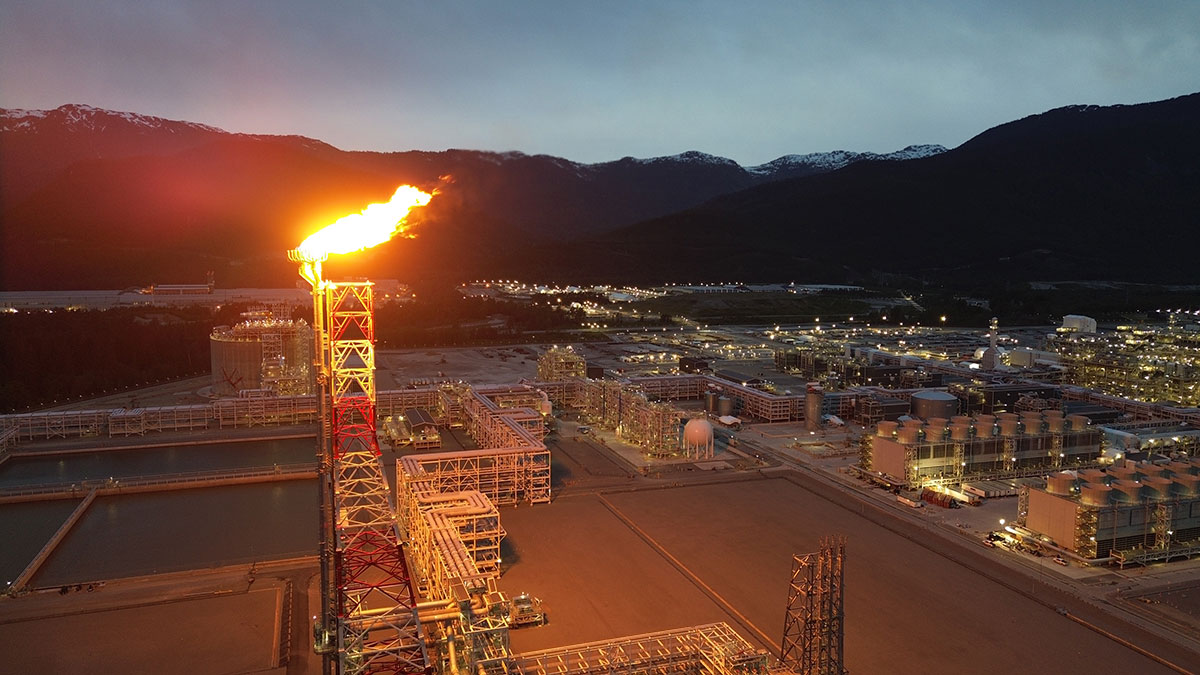Fact-checking the claims of B.C.’s ‘clean’ liquefied natural gas With a swell in support for LNG projects from the B.C. government, you may be wondering what all the hype is about. Maybe you’ve seen a slick ad campaign or an article telling you that natural gas from B.C. is the ‘cleanest’ LNG in the world and the best way to reduce reliance on U.S. trade.
For more than 10 years Gitanyow Hereditary Chiefs and our independent expert advisers have been researching, analyzing, and evaluating the potential risks and benefits of LNG development. We found that many of the claims made by the LNG industry simply do not have adequate evidence to support them.
Let’s fact-check 10 of the top economic and sustainability LNG claims.
1. CLAIM: LNG is about jobs and prosperity for Canada
REALITY:
- LNG’s short-term, mostly temporary jobs come with long-term devastating climate costs that lock in fossil fuel use for decades. The majority of LNG profits flow to multinational corporations, not local communities. Many corporations advancing LNG in BC are American based, further enriching billionaires south of the border.
- Every dollar invested in LNG is a dollar not invested in renewable energy, efficiency retrofits, and improving the energy grid — all of which create more jobs per dollar spent and are needed for the energy transition.
2. CLAIM: LNG promotes Indigenous partnerships.
REALITY:
- While some First Nations partner with LNG projects, many First Nation leaders oppose them due to environmental risks, impacts on rights and title, and threats to salmon and traditional territories.
- The term ‘economic reconciliation’ has been co-opted and used to disguise and mislead. Assets that are also liabilities like pipelines, which aren’t needed in a world transitioning to clean renewable energy, are being off-loaded to Indigenous nations through federal loan guarantees that bail out corporations who require government subsidies to make their projects economically viable.
True economic reconciliation would involve developing projects in partnership with Indigenous peoples that live up to their own visions for sustainability.
3. CLAIM: LNG helps Canada access Asian markets and reduce dependence on the U.S.
REALITY:
- Global LNG demand is volatile and declining. The International Energy Agency projects a peak in fossil gas demand by 2030. Asian countries like Japan and South Korea are investing heavily in renewables and hydrogen, not long-term LNG deals.
- LNG markets are risky and oversupplied, increasing the chances that Canadian projects will be left rusting on the land as abandoned stranded toxic assets.
4. CLAIM: Canadian LNG is ‘responsibly produced’ and lower carbon than other sources.
REALITY:
- LNG is a fossil fuel and the touted “low-carbon” LNG produces significant emissions from fracking, methane leaks, the liquefying process, transport, and combustion. Methane is over 80 times more potent than CO₂ over 20 years and is a serious climate problem.
5. CLAIM: Canada is helping other countries reduce emissions by replacing coal with LNG.
REALITY:
- The “coal-to-gas” switch is a myth. Studies show that LNG often displaces renewables, not just coal, especially where the clean energy transition is underway. LNG can delay clean energy buildout.
- Lifecycle emissions of LNG (including methane leaks) can be as bad or worse than coal. It is not “clean” energy.
6. CLAIM: It’s better for Japan and Korea to buy LNG from Canada than from Qatar or the U.S.
REALITY:
- We don’t reduce global emissions by fighting over who gets to sell fossil fuels. The real goal is to speed up clean energy choices around the world — not just offer a slightly cleaner version of the same problem.
- Longer shipping distances are a minor part of total emissions compared to upstream extraction and combustion.
7. CLAIM: LNG supports high-quality labour standards and environmental protections.
REALITY:
- High standards should apply to any project and don’t justify expanding fossil fuels.
- Transition plans for workers and sustainable jobs offer far more long-term stability than a boom-and-bust fossil fuel industry.
8. CLAIM: LNG Canada’s emissions are 60 per cent lower than the global average.
REALITY:
- Even 60 per cent lower still means millions of tonnes of climate-destroying CO₂ and methane.
- LNG projects will produce emissions that aren’t aligned with B.C.’s own climate targets under the CleanBC plan.
9. CLAIM: Phasing out fossil fuels takes time and LNG is a needed bridge.
REALITY:
- LNG is a speed ramp to more climate destruction. The world needs to cut emissions by nearly half this decade. Building new LNG infrastructure in 2025 that will operate until 2055 is reckless.
- Clean energy is now cheaper, faster to set up, and creates more jobs than fossil fuels.
10. CLAIM: If we didn’t do this, Canada would miss out — others would build it anyway.
REALITY:
- Following others off a cliff is not leadership. B.C. has the potential to lead in renewable energy, conservation, and Indigenous-led solutions rather than LNG exports.
Check out these resources to learn more about LNG’s false claims:
Canada’s Claims of “Low-Emission” LNG Are Not Accurate
Well-to-Tank Carbon Intensity of Canadian LNG
Buried Burdens: The True Costs of Liquified Natural Gas (LNG) Ownership
